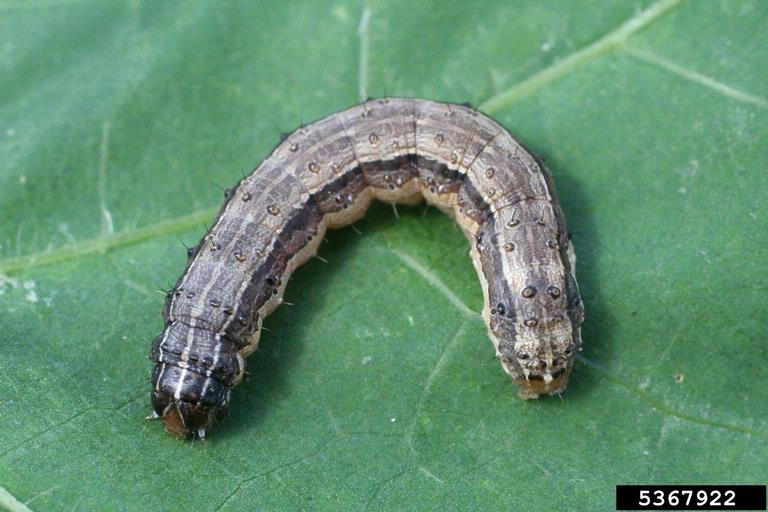Few pests elicit as much anxiety and frustration from pasture and hayfield owners than knowing fall armyworms (FAW) are on the march. These pests can quickly devour a field of fescue, pearl millet, forage mixes, and lawns, and then disappear, leaving little left for growers to salvage.
As the name implies, this is a fall pest but it begins to start showing itself in late summer. Armyworms cause damage by chewing on plant tissue, and they are generally most active in the early morning or late afternoon when temperatures are cooler. In newly cut hay or shorter grass, armyworms will hide in the thatch and topsoil layers during the heat of the day; however, they can be seen foraging in tall grass during any part of the day.
When unchecked, populations of FAW can explode and cause significant economic damage to pastures. The FAW has already been spotted in some local pastures, so growers and homeowners need to closely monitor their fields and scout for signs of these pests. For those who may not be sure what to look for, the FAW is a fairly large caterpillar, and can be up to 1.5 inches long, and can range in color from light green to nearly black with light and dark stripes that stretch horizontally along the body of the worm. One of the pest’s most distinct characteristics is an inverted Y-shape on its head.
The adult form of the fall armyworm is a moth, which is active at night. Females lay between 50 and several hundred eggs in masses that hatch in just a few days. The life cycle from egg to moth takes about 28 days in the warm weather of August and September. The larvae take several weeks to develop. When they are small, they don’t eat much, but when they molt to the last stage, they can eat up an entire pasture in four to five days.
Newly hatched fall armyworms are white, yellow or light green, but darken as they mature. While the youngest larvae do not eat much, the larger, mature larvae can eat more than all other ages put together. Depending on the forage type and conditions, damage may look different. For example, on closely grazed pastures, damage may look like thinned out grass and brown spots, which on a dry year could be misdiagnosed as drought damage. In hayfields or pastures with tall growth, damage can be devastating, as nearly all tender green grower will be consumed, and quickly.
Catching these pests before you have a full-blown infestation is paramount. Thus, targeting these caterpillars when they are small, ideally of a half-inch or less is important. First, the caterpillars do not cause severe damage until they reach a size of one inch in length. Second, as with many pests, smaller larvae are much more susceptible to insecticide control than larger ones.
Folks should not treat a lawn or a field if it is not needed; however, circumstances can change quickly, so landowners need to scout regularly for the presence of fall armyworms. Preventive insecticide treatments are not practical because outbreaks of fall armyworms tend to be random and mortality caused by their natural enemies is usually quite good. Unnecessary insecticide applications can eliminate those natural enemies, and ultimately lead to a worse armyworm problem following treatment.
Careful scouting is the best way to prevent economic losses. Look for signs of armyworms in dead grass and in the thatch layer. Flocks of birds congregating are a typical sign of infestation. In pastures, finding five caterpillars per square foot is a signal to start treating for fall armyworms. Several insecticides are available that have control over armyworms. They include carbaryl (Sevin and others), diflubenzuron (Dimilin), cyfluthrin, spinosad and zeta-cypermethrin (Mustang Max). Pay careful attention to grazing or harvesting restrictions related to these products.
Scouting options for homeowners include close examination of the turf, possibly in tandem with the use of a soapy water flush. When you pour soapy water over a patch of grass (1/2 oz. dishwashing soap/gallon water), the solution will irritate the larvae, which will drive them up from the soil surface very quickly. Heavily infested turf will also have visible greenish-black fecal pellets, or “frass,” on the soil surface.
Other indicators of armyworm infestations may include high numbers of birds or even paper wasps that use the fall armyworms as food. If present, the caterpillars will become visible in about 60 seconds, as they are irritated by the flush and will leave their hiding places in the thatch to escape it.
In addition to the birds and beneficial predators, a number of other insects feed on armyworms, including tiger beetles and other ground beetles. Fall armyworms, like many other turf infesting caterpillars can also be heavily parasitized by tiny wasps that kill the caterpillars and cause no harm to humans or pets. These natural enemies can be conserved by spot rather than blanket spraying and properly timing control efforts.
Products containing Bt (Bacillus thuringiensis) are effective only on little (a half-inch or smaller) worms. Irrigate before treating, to move the caterpillars out of the thatch. Treat in late afternoon, when the caterpillars are likely to begin feeding. If possible, mow before you treat, and then don’t mow for three days after the treatment.
For more information or if you need assistance identifying armyworms, contact the Extension office.

Mature fall armyworm, larvae are about 1-inch to 1.5 inches long, and are generally most active in the morning or late afternoon.